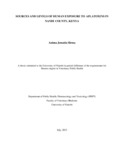| dc.description.abstract | Aflatoxins are by-products of fungal metabolism mainly synthesized by fungus of the genus Aspergillus. In Kenya, the risk of chronic exposure to aflatoxins from susceptible foods, especially maize, which is a staple food is of major concern owing to the health hazards associated with it. However, focus in the country has been on acute aflatoxicosis due to the outbreaks that have occurred in the past. The aim of this study was to determine the levels of aflatoxins in dietary foods considered main sources of exposure that include maize, sorghum, millet and cow milk. A cross sectional survey covered 261 households constituting 101, 63 and 97 from Laboret, Kilibwoni and Chepkongony sub-locations. Human milk and urine samples were also collected and analysed to determine the exposure levels to children under age of 5 and their anthropometric measures taken to determine their nutritional status. Questionnaires were administered to household heads to assess knowledge, attitudes and practices towards aflatoxins. Aflatoxins determination was done by Enzyme Linked Immunosorbent Assay (ELISA) and High Performance Liquid Chromatography (HPLC).
Mean household size across the sub-locations was six, with their main source of earnings being from sales of livestock/fish/milk. Gender distribution among study participants was at a ratio of 1:1 (male: female). Education levels significantly differed across the sub-locations (p<0.001). Kilibwoni had the highest number of persons having attained university education.
Sixty seven point nine percent (72/106), 73.3% (44/60) and 65.7% (67/102) of maize samples collected from Laboret, Kilibwoni and Chepkongony were contaminated with aflatoxins ranging between 0.17 – 5.3 ppb. Ninety two point nine percent (13/14), 100% (9/9) and 87.5% (14/16) of millet samples from Laboret, Kilibwoni and Chepkongony were positive for aflatoxin at a range of 0.14 – 6.4 ppb. Fifty percent (9/18), 36.4% (8/22) and 27.3% (6/22) of sorghum samples from
Laboret, Kilibwoni and Chepkongony, respectively were contaminated with aflatoxins beyond Kenya Bureau of Standards (KEBS) maximum tolerable limits of 10 ppb.
Prevalence of aflatoxin M1 in cow milk was 50.5% (52/103), 49.2% (32/65) and 55.7% (54/97) from Laboret, Kilibwoni and Chepkongony, respectively but none exceeded the allowable limit of 0.05 ppb by Food and Agriculture Organization (FAO) and World Health Organization (WHO) limits.
Average consumption of maize flour was 0.26, 0.33 and 0.30 kg/person/day from Laboret, Kilibwoni and Chepkongony, respectively. This translated to aflatoxin exposure levels from maize flour of 0.3, 0.4 and 0.2 μg/kg/household/day from Laboret, Kilibwoni and Chepkongony, respectively. The average milk consumption was 0.55 litres/person/day from Laboret and 0.48 litres/person/day each from Kilibwoni and Chepkongony sub-locations. The exposure from milk from Laboret, Kilibwoni and Chepkongony was 0.0005, 0.0007 and 0.0005 μg/l/household/day respectively.
Seventy three point nine percent (17/23), 57.1% (8/14) and 43.3% (13/30) of human milk samples from Laboret, Kilibwoni and Chepkongony, respectively were positive for aflatoxin M1. Amongst urine samples, 94.9% (93/98), 88.9% (56/63) and 88.1% (74/84) from study children from Laboret, Kilibwoni and Chepkongony, respectively were positive for aflatoxin M1.
The percentage of children in various nutritional status categories from Laboret {44.7% (17/38)}, Kilibwoni {31.3% (10/32)}and Chepkongony {30.8% (8/26)} were stunted; 0%, 9.4% (3/32) and 3.8% (1/26) respectively were underweight and 2.6% (1/38), 3.1% (1/32) and 11.5% (3/26) respectively were wasted.
From the questionnaire survey, 68.3% (69/101), 60.3% (38/63) and 90.7% (88/97) of respondents from Laboret, Kilibwoni and Chepkongony, respectively identified colour change as the number one criteria for detecting spoilt maize. Twelve point nine six percent (13/101), 22.2% (14/63) and 5.2% (5/97) of respondents from Laboret, Kilibwoni and Chepkongony respectively identified aflatoxicosis as a risk of consuming spoilt grains. In the same order of sub-locations 6.9% (7/101), 0% and 1% (1/97) identified cancer as a health risk of exposure to aflatoxins. On perception of consumption of milk from cows fed on mouldy feed; 51.5% (52/101), 76.2% (48/63) and 72.2% (70/97) of respondents from Laboret, Kilibwoni and Chepkongony felt it was safe.
This study concludes that there is low knowledge on health risks of aflatoxins in Nandi County and that their common dietary foods (cereals and milk) are contaminated with aflatoxins posing a risk of chronic exposure to the residents. There is need for awareness creation on aflatoxins in the study sites and in the country especially in areas where acute aflatoxicosis has never occurred to sensitize people on health hazards associated with aflatoxin contamination. In addition, there is need to promote proper practices of grain production and storage to prevent contamination with aflatoxins and reduce exposure. | en |

